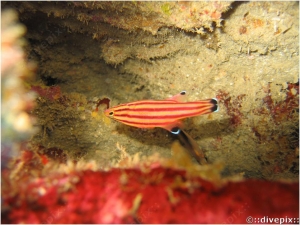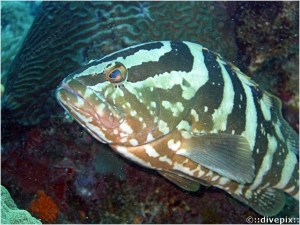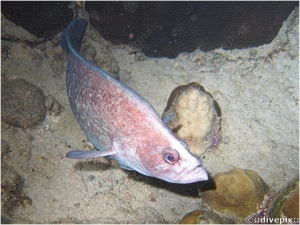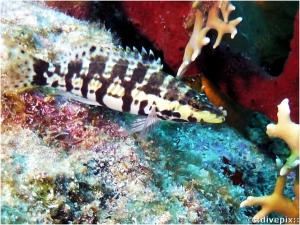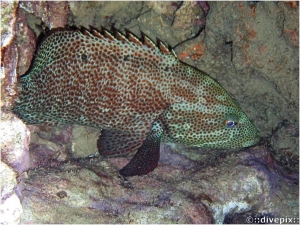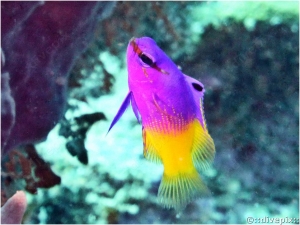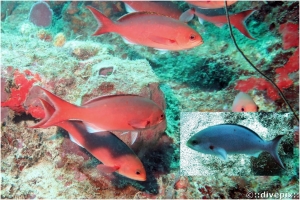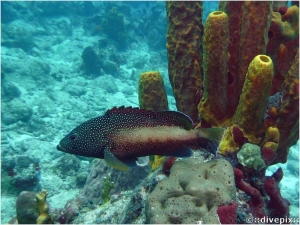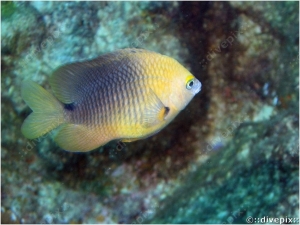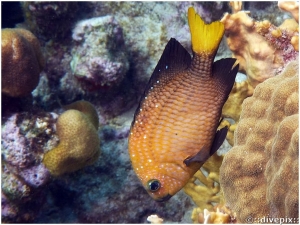




Eric H. Biass
Peppermint Basslet or Swissguard Basslet
| Aspect: | Small, orange streamlined body, with four main darker (red) lines running from snout to tail, plus thin dorsal and underbelly lines. Named after the candy, not the plant, hence Swissguard Basslet appears as a more appropriate designation. |
| Population: | Scarce. |
| Notable feature: | One black spot on dorsal and anal fins, plus to separate black blotches on tail fin, trailing edges of these fins are bordered by a white line. |
| Environment: | Close to bottom, in dark rock recesses. |
| Behaviour: | Shy, and a rare sight. |
Nassau Grouper
| Aspect: | At 60 to 70 cm, is amongst the larger groupers here, has typical sea bass outline, but invariably features a zebra and marbled light grey-dark grey body with shades of red-brown under lower jaw and belly. |
| Population: | Used to be an event when encountered, but not only has presence noticeably increased since 2012, it also has spread around Ilets Pigeon. |
| Notable feature: | Traces of yellow on the upper edge of dorsal fin and dark spot straddles upper tail base. |
| Environment: | Close to bottom in quiet waters, around rocks and coral boulders. |
| Behaviour: | Surprisingl wary for such a large fish, swims away. |
Greater Soapfish
| Aspect: | Bronze-stained grey-blue-white body with prominent rounded dorsal, pectoral, anal and tail fins. |
| Population: | Common, but difficult to spot as it seldom ventures out of recesses, |
| Notable feature: | Thin, pointed nose, eyes surrounded by darker large shaded area. Owes its name to a toxic "soapy" mucus it secretes when it feels threatened. |
| Environment: | Close to bottom in quiet waters, around rocks and coral boulder recesses, mostly seen at night. |
| Behaviour: | Extremely shy (always looks like a scared Cocker Spaniel dog). |
Harlequin Bass
| Aspect: | Small streamlined body, silver base colour upper half, yellow lower half, crossed by six to seven vertical bars, the last and thickest on the tail base. Translucent pectoral and anal fins. CAUTION: earlier designation Serranus tigris no longer accepted (now tigrinus) |
| Population: | Common, but difficult to spot. |
| Notable feature: | Much smaller than photos suggest. 1st half of the long dorsal fin deeply serrated and usually deployed. |
| Environment: | Quiet waters, always close to rocks and coral boulder recesses. |
| Behaviour: | Can be approached, but difficult to photograph. |
Graysby
| Aspect: | Amongst the smaller groupers with the Coney, features typical sea bass outline, but also comes in a variety of somewhat marbled colours, including pale green-bronze with brown dots, white-pink with red dots dark grey, but also plain brass with red dots. However, it must be born in mind that the Graysby can drastically change colour as evidenced by the first two photos below showing the same fish a few seconds apart! |
| Population: | Ubiquitous. |
| Notable feature: | Whatever the overal livery, three dark spots along base of dorsal spine differentiates it from the similarly sized Coney, or larger Red and Rock Hinds. |
| Environment: | Close to bottom in quiet waters, around rocks and coral boulders. |
| Behaviour: | Quiet, sociable. |
Fairey Basslet
| Aspect: | Bright blue /purple colour fades to orange midbody and finally turns bright yellow aft; very long and pointed blue or purple pelvic fins. |
| Population: | Common. |
| Notable feature: | Sophisitcated colour scheme with red/dark red line from snout across the eyes, plus black stain on the dorsal fin combine to fool the observer's eye on the actual orientation of the fish, especially when it rests belly up against the ceiling of a rock ledge. |
| Environment: | Close to bottom in quiet and relatively shallow waters, around rocks and coral boulders that offer quick shelter. |
| Behaviour: | Wary, very small and in constant movement, thus extremely difficult to photograph except in aquariums (which is generally the case). |
Creolefish
| Aspect: | Most of the time, the Creolefish will appear to a diver as a blue-silver taut body fish, first because it rarely let itself be approached very closely and secondly because it generally resides at depths where its pinkish colour is no longer transmitted. When adequately lit, however, its pink/purple-ish colour can turn red-orange, but always with a yellow tinge in the snout area. Deeply forked tail fin and darker edge on the dorsal fin. |
| Population: | Common. Often appears in groups. |
| Notable feature: | Five dark or light dots on either side of the dorsal fin (usually the first three are more clearly visible), and a bright red stain at the base of the pectoral fin (but usually appears black for the reasons explained above). |
| Environment: | Deeper reefs (20+ metres), relatively close to the bottom, feeds on zooplankton. |
| Behaviour: | Wary, difficult to approach, always moving. |
Coney
| Aspect: | Amongst the smaller groupers, the Coney features typical sea bass outline, but comes in a variety of colours, that here include dark grey, bronze, red and orange, plus the Bicolour Variation. All feature dark-rimmed white dots on upper body and sides, except the bicolour variation which can carry dark spots. |
| Population: | Ubiquitous. |
| Notable feature: |
General: Distinctive pair of small dark dots on lower lip, but total lack of dark spots along base of dorsal spine differentiates it from the similarly sized Graysby, or larger Red and Rock Hinds. Bicolour: the juvenile bicolour Coney boasts white specs, usually three, in the upper aft body area. |
| Environment: | Close to bottom in quiet waters, around rocks and coral boulders. |
| Behaviour: | Quiet, sociable. |
Threespot Damselfish
| Aspect: |
Thus called because juveniles boast three black spots, one on the base of the pectoral fin, another at the base of the dorsal fin and finally a black saddle on upper base of the tail fin. Juvenile: Yellow with the three afore-mentioned black spots. Intermediate and adult: upper central body area and dorsal fin gradually turn darker while the dorsal fin spot disappears. In its terminal phase the fish is almost entirely dark brown, though ventral area and tail fin remain yellowish. All Damselfishes have similar outlines, but with more or less deeply pronounced "chin-pectoral" area and dorsal fin tips of various shape. |
| Population: | Common. |
| Notable feature: |
Yellow upper "eyelid" Juvenile: black spot on base of dorsal fin. Intermediate and adult: pale blue snout. |
| Environment: | Rocky areas, coral boulders. |
| Behaviour: | Can be approached, curious, but constantly moves. |
Yellowtail Damselfish
| Aspect: | All Damselfishes have similar outlines, but with more or less deeply pronounced "gullet-pectoral" area, and dorsal fin tips of varying shape. They live through the three distinctive phases described below. |
| Population: | Abundant. |
| Notable feature: |
Adult has dark snout, bronze/light brown young body featuring dorsal spots, turns darker brown with age, but tail remains bright yellow at all times. Adult body can turn yellow with purple dotted scales when courting (see photo below). Juvenile is dark blue with light blue/white spots on its dorsal area and has a translucent tail fin. Very small, constantly moves, often lives under the protection of Long-spine Sea Urchins. Intermediate is like Juvenile, but slightly larger and already sports its definitive bright yellow tailfin. |
| Environment: | Rocky areas, coral boulders. |
| Behaviour: | Can be approached, curious, but constantly moves. |



